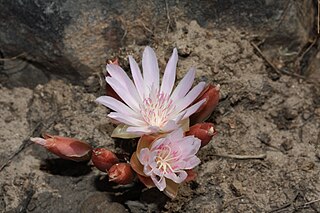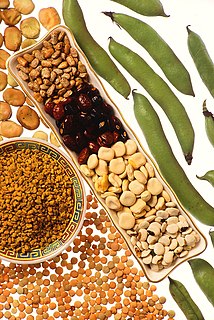
Felidae is a family of mammals in the order Carnivora, colloquially referred to as cats, and constitute a clade. A member of this family is also called a felid. The term "cat" refers both to felids in general and specifically to the domestic cat.

Bitterroot is a small perennial herb in the Montiaceae family. Its specific epithet rediviva refers to its ability to regenerate from dry and seemingly dead roots.

Rosewood refers to any of a number of richly hued timbers, often brownish with darker veining, but found in many different hues.

Lewisia is a plant genus, named for explorer Meriwether Lewis, who encountered the species in 1806. The native habitat of Lewisia species is north facing cliffs in western North America. Local Native Americans ate the roots, which have also been used to treat sore throats.

A species that is extinct in the wild (EW) is one that has been categorized by the International Union for Conservation of Nature as known only by living members kept in captivity or as a naturalized population outside its historic range due to massive habitat loss.
Swartzia macrosema is a species of legume in the Fabaceae family. It is found only in Ecuador. Its natural habitat is subtropical or tropical moist montane forests.

Swartzia is a genus of legume in the Fabaceae family. It was named in honor of Swedish botanist Olof Swartz and contains about 200 species. Swartzia is restricted in its geographical distribution to the New World Tropics, where it occurs primarily in lowland rainforests, but also in savannas, pre-montane forests, and tropical dry forests. While it can be found throughout the wet lowlands from Mexico and the Caribbean islands to southern Brazil and Bolivia, Swartzia is most abundant and species-rich in Amazonia, where 10–20 species may co-occur at a single site. The species of Swartzia are mostly trees, ranging from small understory treelets to large canopy emergents. Some species, especially in savannas, are mult-stemmed shrubs.
Swartzia bombycina is a species of legume in the Fabaceae family. It is found only in Ecuador. Its natural habitat is subtropical or tropical moist lowland forests.
Swartzia fistuloides is a species of legume in the Fabaceae family. It is found in Angola, Cameroon, Republic of the Congo, Democratic Republic of the Congo, Ivory Coast, Equatorial Guinea, Gabon, Ghana, and Nigeria. It is threatened by habitat loss.
Swartzia haughtii is a species of legume in the family Fabaceae. It is found only in Ecuador. Its natural habitat is subtropical or tropical moist lowland forests.
Swartzia littlei is a species of legume in the Fabaceae family. It is endemic and found only in Ecuador. Its natural habitat is subtropical or tropical moist lowland forests.
Swartzia macrophylla is a species of legume in the family Fabaceae. It is found only in Colombia.
Swartzia nuda is a species of legume in the family Fabaceae. It is found only in Panama. It is threatened by habitat loss.
Swartzia oraria is a species of legume in the family Fabaceae. It is found only in Colombia.
Swartzia robiniifolia is a species of legume in the family Fabaceae. It is found only in Colombia.
Swartzia santanderensis is a species of legume in the family Fabaceae. It is found only in Colombia.
Juniperus gamboana is a species of conifer in the Cupressaceae family. It is found in Guatemala and Mexico. It is threatened by habitat loss.

Juniperus monticola, or Mountain juniper, is a species of conifer in the family Cupressaceae. It is found only in Mexico.

The dragon tube-nosed fruit bat is a species of bat in the family Pteropodidae. It is found on both sides of New Guinea: West Papua, Indonesia and Papua New Guinea. It is slightly smaller and very similar in appearance to N. albiventer, differing by having more profuse, dark spotting on its wing membranes, and smaller shorter canines. The similarity between the species has been a source of possible misidentifications. The records of this species from Papua New Guinea are associated with freshwater swamps and rivers.
Terminalia ivorensis is a species of tree in the family Combretaceae, and is known by the common names of Ivory Coast almond, idigbo, black afara, framire and emeri.

In computing, a Digital Object Identifier or DOI is a persistent identifier or handle used to identify objects uniquely, standardized by the International Organization for Standardization (ISO). An implementation of the Handle System, DOIs are in wide use mainly to identify academic, professional, and government information, such as journal articles, research reports and data sets, and official publications though they also have been used to identify other types of information resources, such as commercial videos.












